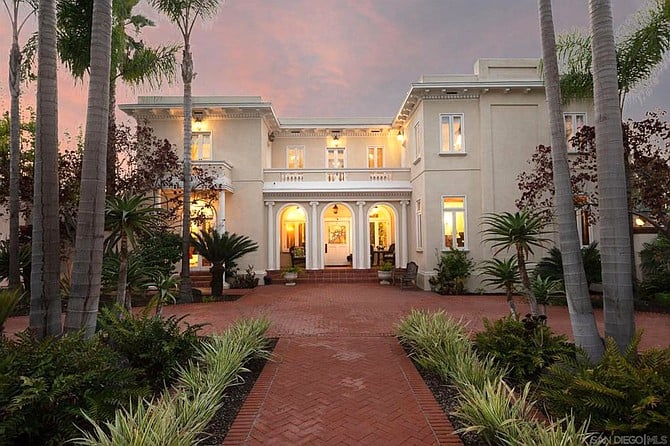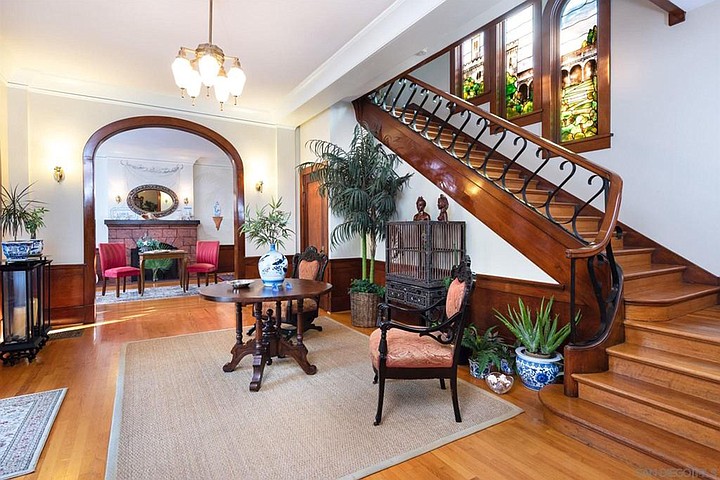 Facebook
Facebook
 X
X
 Instagram
Instagram
 TikTok
TikTok
 Youtube
Youtube

The majestic MacMullen Home at 382 Glorietta Boulevard is the first building visitors to Coronado encounter when crossing the Bay bridge from downtown San Diego. Built in 1914, the home was first occupied by James MacMullen, who from 1899 until 1933 served first John Spreckels and then Ira Copley as editor and manager of the San Diego Union and Evening Tribune daily papers. It was designed by his son, Colonel J.D. MacMullen. The elder MacMullen was so enamored with the project that on April 13, 1913 he published architectural sketches of his as-yet unbuilt mansion in that day’s edition of the Union.

The U-shaped, two-story Italian Renaissance-styled stucco home is defined on the outside by square Ionic columns between three archways that lead to the entryway and support one of the home’s two second-floor decks. Cornice molding protrudes from the flat roof atop bracketed dentils at regular intervals, and both arched and transom windows are visible from the red brick semicircular drive.
The interior of the six-bedroom, four-bath home, comprising more than 3500 square feet of living area, appears to retain much of its original character from photos retrieved on realtor.com. Though renovations were reportedly done in 1942 and again in 1958, the home’s original hardwood floors, grand entry staircase, arched wood passageways, and dual-toned interior doors all appear to be intact.
The kitchen’s countertops have been updated to a solid stone surface and a professional-grade double range has been installed, but the checkerboard tile floors and formal dining room with built-in China cabinet call back to an earlier era, as does the living room with its brick fireplace and deep wood paneling with exposed beam ceilings.
The powder room downstairs has been updated with a modern vessel-style sink, perched on a retro-style chest vanity, and many windows appear to have been upgraded for energy efficiency, but other baths retain their turn-of-the-last-century style. That includes the owner’s suite, where the bath is outfitted with mosaic floor tile, a freestanding claw-foot tub, and antique toilet with an elevated gravity-feed tank.
The lot, at just over a quarter-acre, is on the large side for Coronado, and is landscaped with mature plants and trees and features several private walled garden spaces along with a two-car garage that was added in 1931.
While grand, the Glorietta home was far from the younger MacMullen’s largest architectural accomplishment. A decorated veteran of both world wars, in the aftermath of World War I, he was tasked with the construction of more utilitarian military structures in France, including the country’s biggest laundry facility.
The mansion stayed in the MacMullen family for some time after James Sr. died in 1933; a report eleven years later indicates his granddaughters were still living there as J.D. took command of Camp Callan, a World War II-era Army training base in La Jolla that is today the site of Torrey Pines Golf Course and the UCSD campus.
After the MacMullens moved on, their home changed hands several times. It was most recently acquired in 1998 by real estate developer Richard Rauber and his wife Patricia for a reported $550,000. Aside from a canceled listing for $725,000 in 2002 and an attempt to rent the property for $17,500 per month in 2012, the home has not been publicly advertised until now.
In early October, the MacMullen house once again hit the open market. Its asking price, $3.2 million, remains unchanged to date.


The majestic MacMullen Home at 382 Glorietta Boulevard is the first building visitors to Coronado encounter when crossing the Bay bridge from downtown San Diego. Built in 1914, the home was first occupied by James MacMullen, who from 1899 until 1933 served first John Spreckels and then Ira Copley as editor and manager of the San Diego Union and Evening Tribune daily papers. It was designed by his son, Colonel J.D. MacMullen. The elder MacMullen was so enamored with the project that on April 13, 1913 he published architectural sketches of his as-yet unbuilt mansion in that day’s edition of the Union.

The U-shaped, two-story Italian Renaissance-styled stucco home is defined on the outside by square Ionic columns between three archways that lead to the entryway and support one of the home’s two second-floor decks. Cornice molding protrudes from the flat roof atop bracketed dentils at regular intervals, and both arched and transom windows are visible from the red brick semicircular drive.
The interior of the six-bedroom, four-bath home, comprising more than 3500 square feet of living area, appears to retain much of its original character from photos retrieved on realtor.com. Though renovations were reportedly done in 1942 and again in 1958, the home’s original hardwood floors, grand entry staircase, arched wood passageways, and dual-toned interior doors all appear to be intact.
The kitchen’s countertops have been updated to a solid stone surface and a professional-grade double range has been installed, but the checkerboard tile floors and formal dining room with built-in China cabinet call back to an earlier era, as does the living room with its brick fireplace and deep wood paneling with exposed beam ceilings.
The powder room downstairs has been updated with a modern vessel-style sink, perched on a retro-style chest vanity, and many windows appear to have been upgraded for energy efficiency, but other baths retain their turn-of-the-last-century style. That includes the owner’s suite, where the bath is outfitted with mosaic floor tile, a freestanding claw-foot tub, and antique toilet with an elevated gravity-feed tank.
The lot, at just over a quarter-acre, is on the large side for Coronado, and is landscaped with mature plants and trees and features several private walled garden spaces along with a two-car garage that was added in 1931.
While grand, the Glorietta home was far from the younger MacMullen’s largest architectural accomplishment. A decorated veteran of both world wars, in the aftermath of World War I, he was tasked with the construction of more utilitarian military structures in France, including the country’s biggest laundry facility.
The mansion stayed in the MacMullen family for some time after James Sr. died in 1933; a report eleven years later indicates his granddaughters were still living there as J.D. took command of Camp Callan, a World War II-era Army training base in La Jolla that is today the site of Torrey Pines Golf Course and the UCSD campus.
After the MacMullens moved on, their home changed hands several times. It was most recently acquired in 1998 by real estate developer Richard Rauber and his wife Patricia for a reported $550,000. Aside from a canceled listing for $725,000 in 2002 and an attempt to rent the property for $17,500 per month in 2012, the home has not been publicly advertised until now.
In early October, the MacMullen house once again hit the open market. Its asking price, $3.2 million, remains unchanged to date.